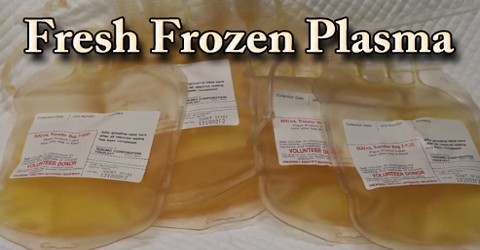
Fresh frozen plasma is the fluid portion of a unit of whole blood that is frozen in a designated time frame, usually within 8 hours.
FFP contains all coagulation factors except platelets.
FFP contains fibrinogen (400 to 900 mg/unit), albumin, protein C, protein S, antithrombin, tissue factor pathway inhibitor.
It is free of erythrocytes and leukocytes.
FFP corrects coagulopathy by replacing or supplying plasma proteins in patients who are deficient in or have defective plasma proteins.
A standard dose of 10 to 20 mL/kg (4 to 6 units in adults) will raise factor levels by approximately 20%.
An increase of approximately 10% of several factors is enough to effect hemostasis.
In addition, FFP provides some volume resuscitation as each unit contains approximately 250 ml.
FFP can only be administered intravenously. FFP must be ABO compatible with the recipient’s red cells.
The FFP bag and fluid upon visual inspection should have no leakage, clots, or abnormal color.
FFP is stored at -30 C.
Prior to administration, FFP is thawed in a water bath at 30 to 37 C over 20 to 30 minutes or in an FDA-cleared device as quickly as 2 to 3 minutes.
FFP should be administered immediately after thawing.
If FFP is not given immediately after thawing, it should be stored at 1 to 6 C. If the thawed FFP is not used in 24 hours, it should be discarded.
Once thawed, the activity of clotting factors, particularly factor V and factor VIII, decline gradually.
After initial dosage, re-administration may be needed every 6 to 8 hours if there is continued bleeding due to the short half-life of factor VII. Factor VII has a half-life of 2 to 6 hours.



